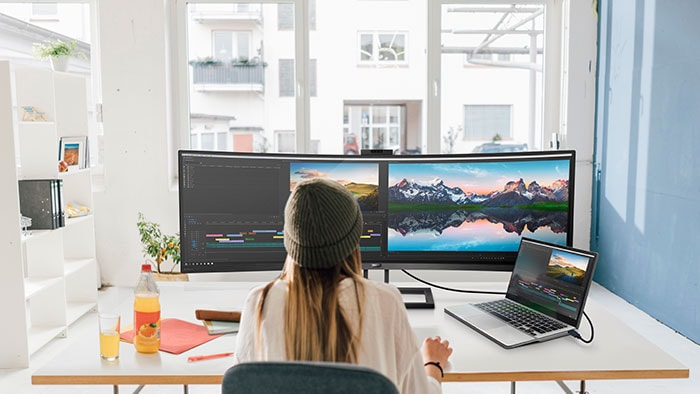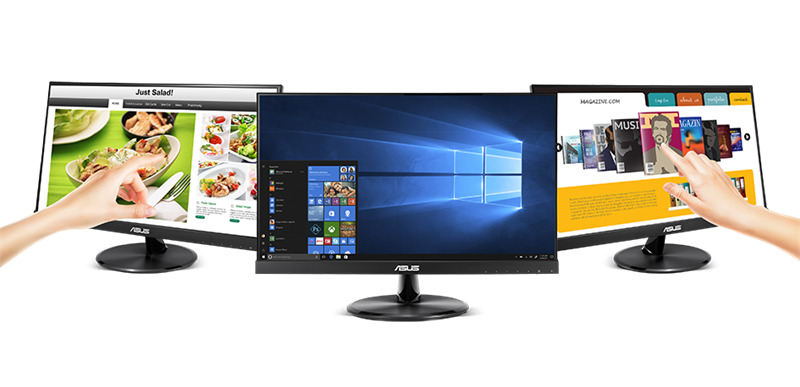Only a select few models rank as the best touchscreen monitors, partially because there aren’t displays sporting touch capabilities. But, whether it’s for creative use, in the office, or just to have a screen that’s a bit more interactive, these displays are worth a look.

Having a touchscreen at your fingertips can help you streamline your workflow as well as make it easier and more intuitive to navigate your day-to-day work. It can save you time and make your setup more versatile. After all, you won’t get that same immediate feedback from even the best mice or keyboards.
That’s not to say all touch displays are worth the investment. Much like how we test monitors, we consider various factors when deciding which ones are worth recommending. We look at how accurate and responsive the touch capabilities are, what the picture quality is, and what kind of features are included, not to mention how well they’re executed.
If you prefer a more traditional monitor, possibly with a higher resolution, check out our best 4K monitors guide. If accurate colours are important to you, whether you’re a photographer or video editor, you might want to invest in one of the best monitor calibrator tools.
+ Flexible stand
+ 5 USB ports
With so many options on the market, our choice of the best touchscreen monitors comes down to the details. And detail is something that Dell's P2418HT monitor does brilliantly. This 1080p monitor on a 23.8-inch panel boasts an LCD screen to deliver excellent resolution, contrast, and colour. Moreover, it boasts an anti-glare surface that works beautifully in distracting light conditions as well as ultra-thin bezels that give it a stylish flair and you more screen real estate.
The ViewSonic TD2230 is small, light and portable touchscreen monitor, making it perfect for anyone with limited desk space and/or who needs to travel with their screen. The 22inches, Full HD, IPS display offers beautifully sharp image quality and high visual accuracy. The screen is also scratch-poof, and the bookstand design allows it to be tilted and adjusted from 20 to 70 degrees, or rested flat.

+ Excellent colour accuracy
+ Several creative-specific features.
While creative professionals usually go for larger screens, there’s definitely a place for portable monitors in content creation. Nomadic users in particular can benefit from a portable monitor that’s designed specifically with video editors, designers, and music producers in mind. The ProArt Display PA148CTV is something of a rarity in the sea of portable monitors with its robust set of features targeted towards creatives. They include the Asus Dial, a physical dial that you can use to make effortless adjustments to your project whether you’re in Lightroom, Premiere Pro, or Photoshop. There’s also the Virtual Control Panel function, which allows you to use the display itself as your touchscreen control panel, simplifying your workflow.

+ 178-degree viewing angles

At the other end of the spectrum, the Viewsonic TD1655 is a small, portable budget 15.6in monitor. It offers 1080p resolution, you can use all 10 fingers on the screen, and you can easily flip the screen to vertical, which can be very useful for those working with code, or if you simply need to scroll through reams of text.
Is a touchscreen monitor worth it?
If you’ve ever used a touchscreen laptop and wished you could do the same at your desk, then the slightly higher price of a touchscreen monitor over its non-touch counterpart is well worth it. After all, there’s no other way to get that kind of nuanced control when navigating various windows and apps. For example, if you want to translate handwriting to text or draw directly on the screen using your finger, one of these panels is the way to do it. And, instead of having to use keyboard shortcuts to carry out a command, you can perform the actual action directly on the screen.
But, you won’t be holding a touchscreen display the way you would a tablet or smartphone. So, consider whether you’re comfortable using your fingers to navigate a screen that’s sitting at eye level for long periods.
What are the disadvantages of a touchscreen monitor?
There are some drawbacks to using a touchscreen monitor. For example, holding your arm up to interact with a touchscreen throughout a day’s worth of work will get tiring no matter how strong you are. And, you’ll have to clean that screen regularly. Otherwise, that buildup of smudges and fingerprints can get in the way of seeing it properly.
You’re also limited in how big a screen you can get since you’ll need it to be within arm’s length to use that touch capability.
Most importantly, however, touchscreen displays are more likely to experience some kind of damage. This is because there’s much more going on under the hood than with non-touch monitors. And, when something goes wrong, it will cost more to fix due to the more complicated design of these panels.




